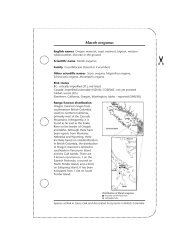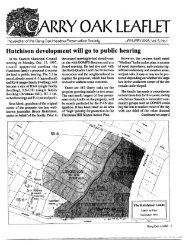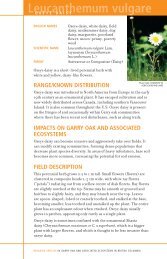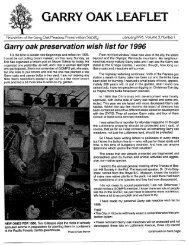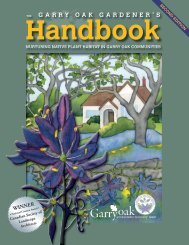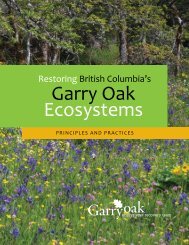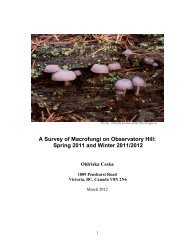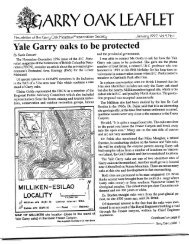PDF 121KB - Garry Oak Ecosystems Recovery Team
PDF 121KB - Garry Oak Ecosystems Recovery Team
PDF 121KB - Garry Oak Ecosystems Recovery Team
You also want an ePaper? Increase the reach of your titles
YUMPU automatically turns print PDFs into web optimized ePapers that Google loves.
Stewardship Account for<br />
Muhlenberg’s Centaury<br />
Centaurium muehlenbergii<br />
Prepared by<br />
Wynne Miles<br />
for<br />
the BC Conservation Data Centre and<br />
the <strong>Garry</strong> <strong>Oak</strong> <strong>Ecosystems</strong> <strong>Recovery</strong> <strong>Team</strong><br />
March 2002<br />
Funding provided by the Habitat Stewardship<br />
Program of the Government of Canada and<br />
the Nature Conservancy of Canada
1. Species Information<br />
STEWARDSHIP ACCOUNT - Centaurium muehlenbergii<br />
a) Name:<br />
Scientific: Centaurium muehlenbergii (Griseb.) Wight ex Piper<br />
Synonyms: C. curvistamineum (Wittr.) Abrams and C. floribundum (Benth.) B.L. Rob. (Missouri Botanical<br />
Gardens - W3TROPICOS November 2001; ITIS November 2001) Kartesz (1994) does not list C.<br />
floribundum as a synonym.<br />
English name: Muhlenberg’s centaury; The name Centaurium is from the greek word kentaurous, referring<br />
to the centaur Chiron who supposedly discovered the medicinal properties of the genus (Hitchcock et al.<br />
1969).<br />
Family: Gentianaceae - Gentian Family<br />
b) Classification:<br />
Centaurium is generally considered to be a taxonomically difficult genus (Cronquist et al. 1984; Hickman<br />
1993; Holmes & Wivagg 1996; Mansion, pers. com., 2001; Pringle, pers. com.; 2001, Turner 1993) and<br />
further work is needed to clarify the taxonomic status of the species within this genus. Dr. Pringle suggests<br />
that the name C. muehlenbergii has been misapplied to C. exaltatum, C. tenuiflorum, C. davyi, C. erythraea,<br />
C. pulchellum, and possibly three or four other species. Similarly he feels the synonym C. floribundum has<br />
often been applied to North American specimens of the naturalized C. tenuiflorum (Pringle, pers. com., 2001).<br />
Guilhem Mansion is currently studying the molecular systematics of the genus Centaurium on a worldwide<br />
basis. His preliminary results suggest it would be useful to recognize a ‘Centaurium muehlenbergii complex’<br />
which includes C. curvistamineum, C. floribundum, and C. tenuiflorum. He also suggests a hybrid origin of<br />
C. muehlenbergii, involving C. erythraea and C. tenuiflorum. Dr J Pringle feels that G. Mansion has<br />
misapplied the name C. muehlenbergii to a naturalized weedy taxon (which is closely related to C.<br />
tenuiflorum and C. erythraea), and that his molecular studies do not relate to the ‘true’ rare C. muehlenbergii<br />
(ie. none of the specimens used for the molecular work were from the ‘true’ rare taxon).<br />
Due to the confusion regarding the taxonomy of C. muehlenbergii it is difficult to ascertain which literature<br />
references to C. muehlenbergii actually pertain to the ‘true’ rare plant, and which references have been<br />
misapplied.<br />
An alternate spelling for the specific epithet is muhlenbergii (Gillett 1963)<br />
c) Similar Species [in B.C.]:<br />
Two other species of Centaurium are recognized in B.C. C. erythraea has a well developed basal rosette and<br />
the flowers are unstalked [or nearly so]. C. exaltatum lacks a well developed basal rosette, the flower stalk<br />
is much longer than the calyx, the calyx is as long or longer than the corolla tube and the anthers measure 0.5<br />
- 1.0 mm. C. muehlenbergii lacks a well developed basal rosette, the flower stalk is shorter than the calyx,<br />
the calyces are shorter than the corolla tubes and the anthers measure 1.5 - 2.0 mm long (Douglas et al. 1999).<br />
Also, see 1 b. Dr. J. Pringle feels that the naturalized C. tenuiflorum is ‘due’ to show up in B.C. (Pringle,<br />
pers. com., 2001).<br />
2. Range and Known Distribution:<br />
a) Global range:<br />
From south west British Columbia south to Nevada and California [ ie B.C., Washington, Oregon, California,<br />
Idaho and Nevada ( Douglas et al. in press; NatureServe 2001)].<br />
The USDA Plants Database indicates that C. muehlenbergii also occurs in Texas, Mississippi and Louisiana
(USDA 2001).<br />
Dr. James Pringle feels that the specimens reported from Nevada are misidentified C. exaltaum, and those<br />
from Texas, Mississippi and Louisiana are C. tenuiflorum (Pringle, pers. com., 2001).<br />
b) Canadian range:<br />
Known only from SW Vancouver Island [Uplands Park, <strong>Oak</strong> Bay], Chatham Island and Stanley Park in the<br />
Lower Mainland (Douglas et al. in press; Donovan, pers. com., 2001).<br />
c) British Columbia range:<br />
• As listed in 2b.<br />
• C. muehlenbergii has not been collected in the Lower Mainland [Stanley Park]since1911.<br />
• It was collected at a minimum of two locations on Chatham Island in 1976.<br />
3. Habitat Description<br />
a) General habitat requirements of the species:<br />
• general habitat type: In B.C. - Moist meadows in the lowland zone [CDFmm, CWHdm] (Douglas et al.<br />
in press), also salt marsh (Donovan, pers. com., 2001);<br />
• Over entire range - coastal bluffs, wet openings in woods, moist places in sagebrush scrub (Pringle, pers.<br />
com., 2001), damp places below 1500', redwood forest, oak woodland and mixed evergreen forest (Munz<br />
1959) [Dr. Pringle feels that some of the characters used by Munz (1959) are questionable.], stabilized<br />
sand dunes (Rittenhouse ____), wet prairies (Guard 1995), faculative wetla nd [FACW ie. usually occurs<br />
in wetlands, but occasionally found in non-wetlands] (Reed 1988), sagebrush scrub, redwood forest,<br />
mixed evergreen forest, northern oak woodland, foothill woodland, valley grassland, northern juniper<br />
woodland (Calflora 2001), serpentine and annual grassland (Callizo et al. 1997); low damp ground, moist<br />
places, south slope and dry prairie (Kinter, per.com., 2001); common to moist open forest in Northern<br />
California (Keeler-Wolf et al. 1998).<br />
• specific habitat type: BC - moist meadows, salt marsh, vernal pools (Donovan, pers. com., 2001).<br />
• specific characteristcs: BC - chernozem-like soil, dark brown with abundant humus incorporated into the<br />
upper horizons; seasonally flooded meadow which dries out during the summer (upland park); margin of<br />
drier Distichalis spicatus marsh [Chatham island]( Donovan, per. com., 2001), Mediterranean-like climate<br />
with dry, warm summers and mild, wet winters (Fuchs 2001).<br />
Over entire range - serpentine formations (Callizo et al. 1997), poorly drained lowland soils or well<br />
drained soils with shallow bedrock impeding drainage allowing standing water to accumulate during the<br />
summer (Wilson 1998a).<br />
• dependence on abiotic and biotic dynamic factors: most abundant in small patches where old wheel ruts<br />
are present, or in shallow depressions where Agrostis sp. does not form a dense cover.<br />
• dynamic factors- no information found.<br />
• associated native and non-native species: Agrostis sp., Cynosurus cristatum, Danthonia californica<br />
Distichalis spicatus, Lolium perenne, Trifolium dubium<br />
• other species at risk occurring in same habitat: 60 other plant taxa are listed as being at risk in <strong>Garry</strong> oak<br />
[Quercus garryana] and associated ecosystems, including 11 designated by the COSEWIC as being at risk<br />
at the national scale. Twelve are at risk on a global scale (Fuchs 2001).<br />
b) Habitat availability and net trends in habitat change:<br />
British Columbia:<br />
• Less than five percent of <strong>Garry</strong> oak ecosystems remain in near natural condition in B.C. Since the arrival<br />
of European settlers approximately 150 years ago, much of the <strong>Garry</strong> <strong>Oak</strong> habitat has been lost due to<br />
agricultural, urban or industrial use. The remaining areas have been impacted by encroachment of woody
Stewardship Account - Centaurium muehlenbergii<br />
4 of 15<br />
species due to fire suppression and invasions of exotic species. It is estimated that less than 1000 hectares<br />
remains in near-natural condition and this is fragmented.<br />
• Victoria, one of the fastest growing urban areas in North America, is located in the centre of the <strong>Garry</strong><br />
oak habitat in BC. It has been estimated that the population could increase by thirty percent in the next 30<br />
years, resulting in further encroachment of the natural areas.<br />
• Fuchs (2001) indicates that additional global warming could increase the range of <strong>Garry</strong> oak and<br />
associated ecosystems.<br />
United States:<br />
• Similar trends exist in <strong>Garry</strong> oak habitats in Washington, Oregon and California. The relationship<br />
between fire history and <strong>Garry</strong> oak [and associated ecosystems] has been studied in all three states (Fuchs<br />
2001). One area that has been well documented is the Willamette Valley in Oregon. Before European<br />
settlement, the Willamette Valley is thought to have been covered by oak savannah and prairie that was<br />
maintained by controlled burning. Fire suppression after European settlement in the 1800's allowed the<br />
growth of dense stands of uniform aged oak trees (Pike 1971; Merifield 2000). C. muehlenbergii is a<br />
common native forb of the remaining wetland prairies of the Willamette Valley (Wilson 2001). These<br />
wetland prairies are highly fragmented and considered among the rarest of Oregon’s ecosystems. The<br />
decline is due to invasion of both woody plant species and pest organisms, agricultural or urban<br />
encroachment and changes in hydrology (Wilson 1998a &b).<br />
• Habitats other than <strong>Garry</strong> oak ecosystems have also been reported for C. muehlenbergii [see3a].<br />
c) Habitat ownership/protection:<br />
• There is no existing legislation that compels any level of government to protect <strong>Garry</strong> oak or associated<br />
ecosystems. Most of the <strong>Garry</strong> <strong>Oak</strong> habitat in B.C. is held by private landholders, and therefore land use<br />
planning falls under jurisdiction of local governments (GOERT 2001). Other areas are managed by BC<br />
Parks, Capital Regional District Parks, Municipal Parks, Songhees First Nation, The Nature Conservancy<br />
of Canada, The Land Conservancy of Canada and The Department of National Defence,<br />
• Management of existing C. muehlenbergii sites in B.C. : Chatham Island is part of the Songhees First<br />
Nation ( phone 250-386-1043). Upland Park is a municipal park managed by the District of <strong>Oak</strong> Bay<br />
(www.district.oak-bay.bc.ca). Stanley Park is managed by the Vancouver Board of Parks and Recreation,<br />
City of Vancouver (www.parks vancouver.bc.ca).<br />
• Amount legally protected: no information found.<br />
4. Status of Species<br />
• endemic to Western North America (Calflora 2001).<br />
• global rank: G5? (Douglas et al. in press) - A global rank of 5 indicates that the taxa is demonstrably<br />
secure across its entire range and usually widespread and abundant. C. muehlenbergii is rare in B.C. but<br />
more common in the southern parts of its range (Hickman 1993; Wilson 2001; Keeler-wolf et al. 1998).<br />
C. muehlenbergii is not included in the Special or Rare Plants Lists maintained by the Natural Heritage<br />
Programs in the states of Oregon, California, Nevada or Idaho (Oregon Natural Heritage Program 2001;<br />
California National Diversity Database 2001; Nevada Natural Heritage Program 2001; Idaho<br />
Conservation Data Center 2001). As it is not a sensitive species in these states, occurrence records are<br />
not available through the Bureau of Land Management (California State Office, BLM 1998; Camp, pers.<br />
com., 2001; Loerentzen, pers. com., 2001).<br />
However C. muehlenbergii is now rated as SH [possibly extirpated] by the Washington Natural Heritage<br />
Program (Washington Department of Natural Resources 2001). It does not appear on the current list of<br />
Rare Plants with Ranks (Washington Natural Heritage Program 2001) as the list has not been updated.<br />
(Caplow, pers. com., 2001). All but one of the Washington collections of C. muehlenbergii were<br />
reassigned to the taxa C. pulchullem by Curtis Bjork and C. Rose Broome. This taxa will probably be<br />
placed in Review Group 2 - taxa with taxonomic questions which must be resolved (Caplow, pers. com).<br />
Dr. Pringle agrees that the species may be extirpated form Washington (Pringle, pers. com., 2001).
Stewardship Account - Centaurium muehlenbergii<br />
5 of 15<br />
• provincial rank: S1, status: red - A provincial rank of S1 indicates that the plant is critically imperiled<br />
because of extreme rarity [less than 5 extant sites] [in this case, one historic site and two extant sites].<br />
• threatened related forms: Centaurium exaltatum is also on the red list in B.C., with a rank of G5 S1.<br />
Centaurium namophilum [spring-loving centaury] is listed as a federally threatened (FT) by the US Fish<br />
and Wildlife Service (USFW Service 2001b) and the Bureau of Land Management in California (BLM in<br />
California 2001). These flowers are endemic to the Ash Meadow wetland in a narrow desert valley about<br />
72 km long situated between Beatty, Nevada and Tecopa, California (University of Nevada 2001). An<br />
Endangered Species <strong>Recovery</strong> Plan is available online (USFW Service 2001b) (Roy, pers. com., 2001).<br />
Centaurium sebaeoides is also listed as FT by the USFW Service. It is only found in Hawaii. (USFW<br />
Service 2001b). C. rigualii is noted as endangered by Gonzalez et al. (1997)<br />
• special scientific interest: Centaurium species have been used in a variety of research topics . The<br />
systematics of the group has been investigated through cytotaxonomic studies (Zeltner 1978,1985,1990<br />
&1991; Broome 1978; Ward 84) molecular systematics (Yuan & Kupfer 95; Mansion, pers. com., 2001),<br />
chemotaxonomical studies (Van der Sluis 1985) and plant anatomy (Rao & Chinnappa 1983a&b). The<br />
phytochemistry of Centaurium species has been studied by a number of authors (Khafagy & Mnajed<br />
1970; Beerhues & Berger 1994; Jankovic et al. 1998; Barillas & Beerhues 1997; Mandal et al. 1992).<br />
• possibility to be confused with other common species: See section 1b. Other authors mention the<br />
possibility of confusing C. muhlenbergii with C. erythraea (Hickman1993), or C. exaltatum and C.<br />
pulchellum (Cronquist et al. 1984).<br />
• genetic importance: Specimens of C. muehlenbergii found in B.C. may be of special interest genetically,<br />
as populations on the periphery of a range may be genetically distinct from the main population and more<br />
vulnerable to disturbances such as climate change (Ward et al. 1998).<br />
• Other Uses: Most members of the Gentianaceae are found to contain a variety of phytochemicals, most<br />
commonly xanthones and secoiridoids. Xanthones are yellow dyes that are pharmacologically active.<br />
Secoiridoids are responsible for the bitter taste of many gentians and are used for their digestive<br />
properties (Mansion, pers.com., 2001). C. erythraea which contains both xanthones and secoiridoids has<br />
a long history of use as a herbal remedy. A translation of a mediaeval Latin poem of the tenth century<br />
mentions Centaury as being powerful against ‘wykked sperytis’. Similarly, C. erythraea is mentioned in a<br />
translation of a slavic medical text form the fifteenth century (Grieve 1992; Jankovic et al. 1998 & 2000;<br />
Ruxic & Simonic 1993). More recently it has been studied by a number of authors. C. erythraea has<br />
been shown to have anti-inflammatory, antipyretic, antioxidant, antimutagenic and diuretic effects<br />
(Berkan et al. 1991;Valentao et al. 2001;Haloui etal. 2000; Schimmer & Mauthener 1996) and has been<br />
used as part of a herbal preparation to treat hyperglycemia (Petlevski et al. 2001). Other Centaurium<br />
species such as C. linarifolium are also known to have medicinal properties (Mandal et al. 1992).<br />
Centaurium spp. are used in the Pacific Northwest by herbalists to prepare a bitter tonic used to treat poor<br />
appetite and digestive problems (Moore 1995). C. muehlenbergii is used by the Mahuna tribe in<br />
California as a laxative. C. venusta is used by the Luisenos tribe to treat fevers.(MPNADB 2001).<br />
• How much of range is protected: no information found<br />
5. Life History<br />
a) General - C muehlenbergii is a small [3 -30(40) cm] annual which blooms from June to early fall and<br />
produces numerous small [
Stewardship Account - Centaurium muehlenbergii<br />
6 of 15<br />
autogamous. Broome’s thesis (1974) contains a section on breeding systems of the Mexican and Central<br />
American Centaurium species. Dr Pringle suggests that it would not be advisable to extrapolate from<br />
generalities about the species, because some species are largely autogamous and some are largely outcrossing.<br />
In some the floral morphology may vary according to growing conditions (Pringle, pers. com., 2001). In the<br />
genus Centaurium, nectary glands are located at the base of the corolla tubes, alternate with the stamens<br />
(Douglas et al, 1999).<br />
d) Reproductive ecology - Most authors refer to C. muehlenbergii as an annual. The PLANTS Database (USDA<br />
2001) lists it as either an annual or biannual. Hickman (1993) suggest that it may persist as abiannual if<br />
damaged. Natural hybridization has been observed between C. erythraea and C. littorale in England (Ubsdel<br />
1979; Vohra 1970). In his ongoing study of the ‘Phylogenetic relationships within the subtribe Chironiinae<br />
[Gentianaceae] with a particular focus on...the genus Centaurium’ Guilhem Mansion proposes that<br />
allopolyploidy has occurred in several clades of Centaurium and that the C. muehlenbergii complex shows<br />
evidence of diverse introgressive hybridization (Mansion, pers.com., 2001).<br />
e) Survival - See 5h. McGee (1985) found that C. erythraea was dependent upon mycorrhizal infection for<br />
growth and survival under conditions of low nutrients.<br />
f) Physiology - With regard to the genus as a whole, Mansion notes that Centaurium species may be found in<br />
various habitats. Most species are calcic olous, some are acidiphilous [C. scilloides] and a few are restricted to<br />
gypseous soils. However, for Centaurium germination and growth, edaphic conditions appear to be of little<br />
importance compared to the amount of available moisture and sunlight (Mansion, pers. com., 2001). Schat<br />
(1983) noted that C. littorale would not germinate without light and that even moderate salinity levels<br />
strongly reduced growth and prolonged the vegetative stage (Schat 1986). Freijsen (1971) and Freijsen &<br />
Van Dijk 1975) studied the differences in growth rate and salt tolerances between different varieties of C.<br />
littorale. Catling & Mckay (1980) studied the ecology of the halophytic species C. pulchellum in southern<br />
Ontario.<br />
g) Dispersal - no information found.<br />
h) Nutrition and interspecific interactions - Schat et al. (1984) studied the response of C. littorale, a biennial, to<br />
nutrient stress and found that growth was limited by phosphorous levels. In another study, Schat et al. (1989)<br />
found that C. pulchellum produced longer [as apposed to more] capsules and therefore more seeds in<br />
eutrophicated sites compared to less fertile sites. As noted in 5e, seedlings of C erythraea were found to be<br />
dependent on mycorrhizal infection for growth and survival, with the plants showing a marked growth<br />
response to infection. Gay et al.(1982) found that seedlings of C. erythraea became mycorrhizal within two<br />
weeks of germination. Both studies found the mycorrhizal species to be a pecuiliar form of vesicualrarbuscular<br />
type.<br />
i) Behaviour/ Adaptability - Mansion suggests that most Centaurium species do not compete well with other<br />
species and therefore are found in disturbed and open places (Mansion, pers. com., 2001). Gay et al. [1982]<br />
describe C. erythraea as ‘turf compatible’ i.e., able to regenerate in closed turf. Some Centaurium species<br />
such as C. erythraea do appear to be very successful weeds. Davies & Waite (1998) found that seeds from C.<br />
erythraea dominated the seed bank in a calcareous grassland area. Bekker et al. (1999) considered C.<br />
littorale a early successional pioneer species. However the seeds persisted in the soil for a significant time.<br />
6. How the Species is at Risk<br />
As discussed in 3b, less than five percent of <strong>Garry</strong> oak ecosystems remain in near natural conditions in B.C.<br />
Within that available habitat, C. Muehlenbergii is apparently restricted to moist open areas. The remaining <strong>Garry</strong><br />
oak habitat is also fragmented and the native species have to compete with aggressive exotics such as Scotch<br />
broom, English ivy, Himalayan blackberry and orchard grass. The remaining habitat has also been impacted by<br />
growth of native shrubs due to fire suppression. Both these native and exotic shrubs pose a problem for C.<br />
muehlenbergii if it does in fact need full sunlight for germination. Turf forming exotic grasses may also be<br />
difficult to compete with.<br />
7. Management Recommendations
Stewardship Account - Centaurium muehlenbergii<br />
7 of 15<br />
A recovery strategy for the <strong>Garry</strong> oak and associated ecosystems has been developed (GOERT 2001). Phase one<br />
focuses on the development of an information base, to protect and manage known sites to minimize immediate<br />
loss, and to motivate protection and stewardship through public education<br />
General management prescriptions:<br />
• Fire exclusion has been identified as the most serious ecological problem facing remnant <strong>Garry</strong> oak<br />
stands in the United States and prescribed fire has been tried as a restoration tool in Washington, Oregon<br />
and California (GOERT 2001; Wilson 1999). A variety of management tools have been tried to control<br />
exotic species, including manual, mechanical, chemical and biological controls, as well as fire. However<br />
success has been limited (GOERT 2001). Management strategies for the wetland and upland prairies of<br />
the Willamette Valley are currently being studied at Oregon Sate University. Prescribed burning has been<br />
effective in controlling woody plants but must be supplemented with additional control of weedy herbs<br />
[manual weed removal, and seeding of native species] (Wilson et al. 1995;Wilson 1999; Clark & Wilson<br />
2001). The use of mowing as a control tool produced mixed results (Bartels &Wilson, in press; Wilson &<br />
Clark 1997; Wilson & Ingersoll 1993; Clark & Wilson 2000a,b). Further research is needed on the timing<br />
and frequency of burns and to determine the long term effects of different techniques (Maret & Wilson<br />
2000; Clark & Wilson 1998b).<br />
• A study by Zwaenepoel & Hermy (1987) in Belgium suggests that mowing, and the maintenance of a<br />
high water table as well as oligotrophic conditions are important for the survival of C. erythraea and C.<br />
pulchullem.<br />
Studies on grassland seedbanks by Dutoit and Alard (1995) found that the naturally occurring seedbanks<br />
in previously species-rich areas [which had been intensely grazed or abandoned] were not sufficient to<br />
restore the area [i.e. recolonization from another source was necessary]. Therefore management of a<br />
species rich grassland had to be designed to preserve the plant community, as well as improving<br />
dispersion from other source areas.<br />
• Research is required to determine the feasibility of reintroducing C. muehlenbergii to restored areas. C.<br />
erythraea, a biennial, is cultivated commercially on a small scale in North Africa and central Europe<br />
(Stuart 1979; Mackova 1988). This species has also been cultured in vitro in laboratory settings, and<br />
propagated from different types of aseptic seedling explants (Amorim & Fernandes 1998). Laboratory<br />
work has also allowed for the micropropagation and in vitro storage of the endangered species, C. rigualii<br />
(Iriondo & Perez 1996). Further work on the same species has allowed for the cryopreservation of nodal<br />
explants using the escapsulation-dehydration method (Gonzalez et al. 1997). In the future, similar work<br />
on C. muehlenbergii could provide plants for restoration work.<br />
• Research is required to determine if C. muehlenbergii is dependent on a mycorrhizal relationship to<br />
maximize its nutritional uptake [as appears to be the case for other Centaurium spp.]. This information<br />
could then be applied to any reintroduction programs<br />
• It would appear that a mixed approach will be necessary to restore the remnant <strong>Garry</strong> oak areas remaining<br />
in B.C. As any management plan will be labour intensive, it would be prudent to be proactive to prevent<br />
new exotics from becoming established.<br />
Specific management prescriptions;<br />
• Removal of exotics from existing moist meadow habitats.<br />
• Removal of native and exotic shrubs from other potential wet meadow areas.<br />
• Reintroduction of C. muehlenbergii.
Stewardship Account - Centaurium muehlenbergii<br />
8 of 15<br />
• The meadows in Uplands Park are used heavily as dog exercise areas. It may be necessary to restrict<br />
access to the meadows during the flowering/seed set period.<br />
• Removing flower/seeds from exotics [such as Scotch thistle] before the seeds mature could be an<br />
effective weed control measure.<br />
8. References/Literature Cited<br />
Amorim, L.R. and F.M. Fernandes. 1998. Micropropagation of Centaurium erytraea from different type of<br />
aseptic seedling explants. In Vitro Cellular & Developmental Biology. Animal 34 (3 Part 2). 62A. (citation<br />
only)<br />
Baresova, H., T. Herben, M. Kaminek and J. Krekule. 1985. Hormonal control of morphogenesis in leaf<br />
segments of Centaurium erythraea. International Symposium on Plant Growth Regulators, Liblice,<br />
Czechoslovakia, June 18-22, 1984. Biologia Plantarum (Prague) 27(4-5): 286-291. (citation only)<br />
Barillas, W. and L. Beerhues. 1997. 3-Hydroxybenzoate: coenzyme A ligase and 4-coumarate: coenzyme A<br />
ligase from cultured cells of Centaurium erythraea. Planta Heidelberg 202(1): 112-116. (abstract only)<br />
Bartels, M.R. and M.V. Wilson. In press. Fire and mowing as management tools for conserving a threatened<br />
perennial and its habitat in the Willamette Valley, Oregon. in Proceedings of the 17 th North American Prairie<br />
Conference.<br />
Beerhues, L. and U. Berger. 1994. Xanthones in cell suspension cultures of two Centaurium species.<br />
Phytochemistry (Oxford) 35(5): 1227-1231. (citation only)<br />
Bekker, R.M., E.J. Lammerts, A. Schutter and A.P. Grootjans. 1999. Vegetation development in dune slacks: the<br />
role of persistent seed banks. Journal of Vegetation Science 10(5): 745-754. (abstract only)<br />
Berkan, T., L. Ustunes, F. Lermioglu and A. Ozer. 1991. Antiinflammatory, analgesic, and antipyretic effects of<br />
an aqueous extract of Erythraea centaurium. Planta Medica 57(1):34-37.<br />
Broome, C.R. 1974. Systematics of Centaurium (Gentianaceae) of Mexico and Central America.<br />
dissertation; Duke University. 429 pp.<br />
Ph.D.<br />
_____. 1978. Chromosome numbers and meiosis in North and Central American species of Centaurium<br />
(Gentianaceae). Systematic Botany 3(3): 299-312.<br />
Bureau of Land Management in California, U.S. Department of the Interior. California BLM Special Status<br />
Plants. Website: http://pub4.ca.blm.gov/caso/ssplist_c.html [accessed November 2001]<br />
CalFlora: Information on California plants for education, research and conservation. 2001. Berkeley, California.<br />
Website: http://www.calflora.org [accessed November 2001].<br />
California Natural Diversity Database (CNDDB). 2001. California Department of Fish and Game, Wildlife and<br />
Habitat Data Analysis Branch. Website: http://www.dfg.ca.gov/whdab/html/cnddb.html [accessed<br />
November 2001].<br />
California State Office, Bureau of Land Management. 1998. California BLM special status plants - SSP list.<br />
Website: http://pub4.ca.blm.gov/caso/ssplist_c.html [accessed November 2001].
Stewardship Account - Centaurium muehlenbergii<br />
9 of 15<br />
Callizo, J., J. Ruygt and G. Muth. 1997. The Flora of Napa County, California. Website:<br />
http://www.puc.edu/Faculty/Gilbert_Muth/napa.htm [accessed November 2001].<br />
Catling, P.M. and S.M. McKay. 1980. Halophytic plants in southern Ontario, Canada. Canadian Field Naturalist<br />
94(3): 248-258. (abstract only)<br />
Clark, D.L. and M.V. Wilson. 1998. Fire ffects in wetland prairie plant species - final report. Prepared for U.S.<br />
Fish and Wildlife Service, Western Oregon Refuges, Corvallis, Oregon. Project no. 14-48-0001-96749.<br />
Available online: http://www.onid.orst.edu/~wilsomar/Persp_Fire.htm<br />
_____ and _____. 2000a. Controlling woody vegetation in wetland prairies (1994-1999). Report to the Coast<br />
Range Resource Area, Bureau of Land Management, Eugene, Oregon. Website:<br />
http://www.onid.orst.edu/~wilsomar/Persp_Wetland.htm<br />
_____ and _____. 2000b. Promoting regeneration of native species in Willamette Valley upland prairies. Report<br />
to the US Fish and Wildlife Service. Available online: http://www.onid.orst.edu/~wilsomar/Persp_Fire.htm<br />
_____ and _____. 2001. Increasing the abundance of rare native wetland prairie species. Report to the US<br />
Bureau of Land Management. Available online: http://www.onid.orst.edu/~wilsomar/Persp_Fire.htm<br />
Cronquist, A., A.H. Holmgren, N.A. Holmgren, J.K. Reveal and P.K Hol. 1984. Intermountain Flora: Vascular<br />
Plants of the Intermountain West, U.S.A. Hafner Pub. Co., New York. Volume 4.<br />
Davies, A. and S. Waite. 1998. The persistence of calcareous grassland species in the soil seed bank under<br />
developing and established scrub. Plant Ecology 136(1): 27-39. (abstract only)<br />
Douglas, G.W., D. Meidinger and J. Pojar. 1999. Illustrated Flora of British Columbia, Volume 3 Dicotyledons<br />
(Diapensiaceae through Onagraceae). Province of British Columbia.<br />
Douglas, G.W., G.B. Straley and D. Meidinger. In press. Rare Native Vascular Plants of British Columbia.<br />
Province of British Columbia.<br />
Dunbar, F.F. 1929. The Gentianaceae of the Pacific Coast. M.A. thesis; Stanford University.<br />
Dunn, R.A. 1967. A revision of the Genus Centaurium of continental United States. Ph.D. dissertation; The<br />
Catholic University of America. 598 pp.<br />
Dutoit, T. and D. Alard. 1995. Permanent seed banks in chalk grassland under various management regimes:<br />
their role in the restoration of species-rich plant communities. Biodiversity and Conservation 4(9): 939-950.<br />
(abstract only)<br />
Formanowiczowa, H. and J. Kozlowski. 1973. Biology of germination of seeds of medicinal plants part 11 the<br />
seeds of Centaurium umbellatum. Herba Polonica 19(2): 160-166. (citation only)<br />
Freijsen, A.H. 1971. Growth physiology salt tolerance and mineral nutrition of Centaurium littorale adaptations<br />
to its oligotrophic and brackish habitat. Acta Botanica Neerlandica 20(6): 577-588. (citation only)<br />
Freijsen, A.H.J. and A. Van Dijk. 1975. Differences in growth rate and salt tolerance between varieties of the<br />
halophyte Centaurium littorale and their ecological significance. Acta Botanica Neerlandica 24(1): 7-22.<br />
(citation only)<br />
Fuchs, M.A. 2001. Towards a recovery strategy for <strong>Garry</strong> <strong>Oak</strong> and associated ecosystems in Canada: ecological
Stewardship Account - Centaurium muehlenbergii<br />
10 of 15<br />
assessment and literature review. Technical report GBEI/EC-00-030. Environment Canada, Canadian<br />
Wildlife Service, Pacific and Yukon Region.<br />
Gay, P.E., P.J. Grubb and H.J. Hudson. 1982. Seasonal changes in the concentrations of nitrogen phosphorus<br />
and potassium and in the density of mycorrhiza in biennia l and matrix forming perennial species of closed<br />
chalkland turf. Journal of Ecology 70(2): 571-594. (abstract only)<br />
Gillett, J.M. 1963. The gentians of Canada, Alaska and Greenland. Research Branch, Canada Department of<br />
Agriculture, Ottawa. Publication 1180. 99 pp.<br />
Goert. 2001. <strong>Recovery</strong> strategy for <strong>Garry</strong> <strong>Oak</strong> and associated ecosystems and their associated species at risk in<br />
Canada: 2001-2006. Prepared by the <strong>Garry</strong> <strong>Oak</strong> <strong>Ecosystems</strong> <strong>Recovery</strong> <strong>Team</strong>. Available online:<br />
http://www.bc.natureconservancy.ca/cgo/index.htm<br />
Gonzalez-Benito, M.E. 1997. Cryopreservation of nodal explants of an endangered plant species (Centaurium<br />
rigualii Esteve) using the encapsulation-dehydration method. Biodiversity and Conservation 6(4): 583-590.<br />
(citation only)<br />
Grieve, M. 1992. A Modern Herbal: The Medicinal, Culinary, Cosmetic and Economic Properties, Cultivation<br />
and Folklore of Herbs, Grasses, Fungi, Shrubs and Trees With All Their Modern Scientific Uses. Tiger<br />
Books International, London.<br />
Guard, B.J. 1995. Wetland Plants of Oregon & Washington. Lone Pine Publishing, Vancouver, British<br />
Columbia. 239 pp.<br />
Haloui M., L. Louedec, M.J. Baptiste and B. Lyoussi. 2000. Experimental diuretic effects of Rosmarinus<br />
officinalis and Centaurium erythraea. Journal of Ethnopharmacology 71(3): 465-472. (abstract only)<br />
Hickman, J.C. [ed.]. 1993. The Jepson Manual - Higher Plants of California. University of California Press.<br />
Berkeley and Los Angeles, California.<br />
Hitchcock, C.L., A. Cronquist, M. Ownbey and J.W. Thompson. 1969. Vascular Plants of the Pacific Northwest.<br />
University of Washington Press, Seattle and London. (Volume 4).<br />
Holmes, W.C., D.E. Wivagg. 1996. Identification and distribution of Centaurium muhlenbergii (Griseb.) Piper<br />
and C. pulchellum (Sw.) Druce (Gentianaceae) in Louisiana, Mississippi and Texas. Phytologia 80(1):23-29.<br />
Idaho Conservation Data Center. 2001. Idaho Fish and Game. Website:<br />
http://www2.state.id.us/fishgame/info/cdc/cdc.htm [accessed November 2001].<br />
Integrated Taxonomic Information System (ITIS). Website: http://www.ITIS.USDA.gov/ index.html [accessed<br />
November 2001].<br />
Iriondo, J.M. and C. Perez. 1996. Micropropagation and in vitro storage of Centaurium rigualii esteve<br />
(Gentianaceae). Israel Journal of Plant Sciences 44(2-3): 115-123. (abstract only)<br />
Jankovic, T., D. Krstic, F.K. Savikin, N. Menkovic and D. Grubisic. 1998. Comparative investigation of<br />
secoiridoid compounds of Centaurium erythraea grown in nature and cultured in vitro. Pharmaceutical &<br />
Pharmacological Letters 8(1): 30-32. (abstract only)<br />
Jankovic, T., D. Krstic, F.K. Savikin, N. Menkovic and D. Grubisic. 2000. Xanthone compounds of Centaureum<br />
erythraea grown in nature and cultured in vitro. Pharmaceutical & Pharmacological Letters 10(1): 23-25.
Stewardship Account - Centaurium muehlenbergii<br />
11 of 15<br />
Kartesz, J.T. 1994. A Synonymized Checklist of the Vascular Flora of the United States, Canada, and Greenland,<br />
Second Edition. Timber Press, Portland, Oregon. 2 volumes.<br />
Keeler-Wolf. T., D.R. Glam, K. Lewis and S.A. Flint. May 1998. Californai vernal pool assessment -<br />
preliminary report. State of California Department of Fish and Game. Website: http://<br />
maphost.dfg.ca.gov/wetlands/vp_asses_rept/index.htm [accessed December 2001].<br />
Khafagy, S.M. and H.K. Mnajed. 1970. Phytochemical investigation of Centaurium pulchellum. Acta<br />
Pharmaceutica Suecica 7(6): 667-672. (citation only)<br />
Kugler, H. 1977. On the pollination of Mediterranean springtime flowers. [German]. Flora 166(1): 43-64.<br />
(English abstract only)<br />
Mackova, A. 1988. Small-plot cultivation of common centaury (Centaurium erythraea Raf. Gentianaceae) in<br />
East Slovakia (Czechoslovakia). Herba Hungarica 27(2-3): 67-74. (abstract only)<br />
Mandal, S., P.C. Das and P.C. Joshi. 1992. Naturally occurring xanthones from terrestrial flora. Journal of the<br />
Indian Chemical Society 69(10): 611-636. (abstract only)<br />
Maret, M.P. and M.V. Wilson. 2000. Fire and seedling population dynamics in western Oregon prairies. Journal<br />
of Vegetation Science 11; 307-314.<br />
McGee, P.A. 1985. Lack of spread of endomycorrhizas of Centaurium (Gentianaceae). The New Phytologist<br />
101: 451-458.<br />
Medical Plants of North America home page (MPNADP). Available through website: http://arsgenome.cornell.edu/botany.htm<br />
[accessed November 2001].<br />
Merrifield, K. 2000. Bryophytes on isolated Quercus garryana trunks in urban and agricultural settings in the<br />
Willamette Valley, Oregon. The Bryologist 103(4): 720-724.<br />
Missouri Botanical Garden W3TROPICOS Nomenclatural Data Base. Web site: http://www.mobot.org<br />
[accessed November 2001].<br />
Moore, M. 1995. Medicinal Plants of the Pacific West. Red Crane Books, Santa Fe, New Mexico.<br />
Munz, P.A. and D.D. Keck. 1959. A California Flora. University of California Press, Berkely, California. 1681<br />
pp.<br />
NatureServe: An online encyclopedia of life [web application]. 2001. Version 1.5. Arlington, Virginia, USA:<br />
Association for Biodiversity Information. Website: http://www.natureserve.org [accessed November 2001].<br />
Nevada Natural Heritage Program. 2001. Department of Conservation and Natural Resources, State of Nevada.<br />
Website: http://www.state.nv.us/nvnhp [accessed November 2001].<br />
Oregon Natural Heritage Program. 2001. Website: http://www.abi.org/nhp/us/or/index.htm [accessed<br />
November 2001].<br />
Petlevski, R., M. Hadzija, M. Slijepcevic and D. Juretic. 2001. Effect of ‘antidiabetis’ herbal preparation on<br />
serum glucose and fructosamine in NOD mice. Journal of Ethnopharmacology 75(2-3): 181-184. (abstract<br />
only)
Stewardship Account - Centaurium muehlenbergii<br />
12 of 15<br />
Pike, L.H. 1971. The role of epiphytic lichens and mosses in production and nutrient cycling of an oak forest.<br />
Ph.D. dissertation; University of Oregon. xiii + 72 pp.<br />
Rao, K.S. and C.C. Chinnappa. 1983(a). Pericolporate pollen in Gentianaceae. Canadian Journal of Botany<br />
61(1): 174-178.<br />
Rao, K.S. and C,C. Chinnappa. 1983(b). Studies in Gentianaceae micro sporangium and pollen. Canadian<br />
Journal of Botany 61(1): 324-336.<br />
Reed, P.B.(Jr.) 1988. National list of plant species that occur in wetlands: 1988 national summary. U.S. Fish and<br />
Wildlife Service. Biological Report 88(24).<br />
Rittenhouse, B. ____ Botanizing the southern Oregon coast (Coos Bay to Port Orford). Website:<br />
http://www.or.blm.gov/coosbay/newriver/oregon_plants.htm [accessed November 2001].<br />
Ruzic, V. and A. Simonic. 1993. Identification of medical plant from glagolitic medical recipe. Acta Facultatis<br />
Medicae Fluminensis 18(1): 5-9. (abstract only)<br />
Schaeppi, H. 1969. On the formation of the shoots in some indigenous Gentianaceae. Vierteljahresschr<br />
Naturforsch Ges Zurich 114 (1): 1-27. (citation only)<br />
Schat, H. 1983. Germination ecology of some dune slack pioneers. Acta Botanica Neerlandica 32(3): 203-212.<br />
(abstract only)<br />
Schat, H. and M. Scholten. 1986. Effects of salinity on growth, survival and life history of four short-lived<br />
pioneers from brackish dune slacks. Acta Oecologica Oecologia Plantarum 7(3): 221-232. (abstract only)<br />
Schat, H., A.H. Bos, M. Scholten. 1984. The mineral nutrition of some therophytes from oligotrophic dune slack<br />
soils. Acta Ecologica 5(19): 119-131.<br />
Schat, H., J. Ouborg and R. De-Wit. 1989. Life history and plant architecture: size-dependent reproductive<br />
allocation in annual and biennial Centaurium species. Acta Botanica Neerlandica 38(2): 183-202.<br />
Schimmer, O. and H. Mauthener. 1996. Polymethoxylated xanthones from the herb of Centarium erythraea with<br />
strong antimutagenic properties in Salmonella typhimurium. Planta Medica 62(6): 561-564. (abstract only)<br />
St. John, H. 1962. Flora of Southeastern Washington and of Adjacent Idaho. Students Book Corporation,<br />
Pullman, Washington.<br />
Stuart, M. 1979. Encyclopedia of Herbs and Herbalism. Classic Bookshops, Rexdale, Ontario.<br />
Turner, B.L. 1993. The Texas species of Centaurium (Gentianaceae). Phytologia 75 (3): 259-275.<br />
Ubsdell, R.A.E. 1979. Variation and evolution in Centaurium erythraea and Centaurium littorale in the British<br />
Isles 3. Breeding systems floral biology and general discussion. Watsonia 12(3): 225-232. (abstract only)<br />
University of Nevada, Reno, Biological Resources Research Center. Website:<br />
http://www.brrc.unr.edu/data/plants/centnamo.html [accessed November 2001].<br />
USDA, NRCS. 2001. The PLANTS database, version 3.1. National Plant Data Center, Baton Rouge, LA 70874-
Stewardship Account - Centaurium muehlenbergii<br />
13 of 15<br />
4490 USA. Website: http://plants.usda.gov [accessed November 2001].<br />
U.S. Fish and Wildlife Service (a), Endangered Species <strong>Recovery</strong> Plans. Website:<br />
http://www.calflora.org/calflora/reference.html #cnps_elect [ac cessed November 2001]<br />
U.S. Fish and Wildlife Service (b), Species Profile. Website: http://ecos.fws.gov/ species_profile.html [accessed<br />
November 2001].<br />
Valentao, P., E. Fernandes, F. Carvalho, P.B. Andrade, R.M. Seabra and M.L. Bastos. 2001. Antioxidant activity<br />
of Centaurium erythraea infusion evidenced by its superoxide radical scavenging and xanthine oxidase<br />
inhibitory activity. Journal of Agricultural & Food Chemistry 49(7): 3476-3479. (citation only)<br />
Van Der Sluis, W.G. 1985. Chemotaxonomical investigations of the genera Blackstonia and Centaurium<br />
Gentianaceae. Plant Systematics & Evolution 149(3-4): 253-286. (abstract only)<br />
Vohra, J.N. 1970. Natural hybridization in Centaurium erythraea and Centaurium littorale at Freshfield and<br />
Ainsdale south Lancashire. Bulletin of the Botanical Survey of India 12(1-4): 144-150. (citation only)<br />
Ward, D.E. 1984. Chromosome counts from New Mexico and Mexico. Phytologia 56(1): 55-59.<br />
Ward, P., G. Radcliffe, J. Kirby, J. Illingworth and C. Cadrin. 1998. Sensitive ecosystem inventory. east<br />
Vancouver Island and Gulf Islands, 1993-1997. Vol. 1 Methodology, ecological descriptions and results.<br />
Technical Reports Series No. 320, CWS, Pacific and Yukon Regions, B.C.<br />
Washington Department of Natural Resources. 2001. State of Washington Natural Heritage Plan: 192 pp.<br />
Olympia. Website: http://www.wa.gov/dnr/htdocs/fr/nhp/refdesk/plan/index.htm<br />
Washington Natural Heritage Program. 2001. Washington State Department of Natural Resources, Asset<br />
Management & Protection Division. Reference desk on website:<br />
http://www.wa.gov/dnr/htdocs/fr/nhp/wanhp.html [accessed November 2001].<br />
Wilson, M.V. 1998a. Wetland Prairie - contributed chapter: part 1 the U.S. Fish and Wildlife Service Willamette<br />
basin recovery plan. U.S. Fish and Wildlife Service, Oregon State Office. Order no. 13420-6-0287 (2).<br />
Available online: http://search.orst.edu<br />
_____. 1998b. Fire effects on wetland prairie plant species. U.S. Fish and Wildlife Service, Western Oregon<br />
Refuges, Corvallis, Oregon. Project no. 14-48-0001-96749. Available online:<br />
http://www.onid.orst.edu/~wilsomar/Persp_Fire.htm<br />
_____. 1999. Evaluating prescribed burning to improve prairie quality in the Willamette floodplain research<br />
natural area, W.L. Finly National Wildlife Refuge, Oregon. Submitted to U.S. Fish and Wildlife Service,<br />
Western Oregon Refuge Complex. Agreement 14-48-0001-96749. Available online: http:// search.orst.edu<br />
_____. 2001. Willamette Valley Prairies - research from Oregon State University. Website:<br />
http://www.onid.orst.edu/~wilsomar/WetNatForbs.htm [accessed November 2001].<br />
Wilson, M.V. and D.L. Clark. 1997. Final report 1994-1997. Effects of fire, mowing, and mowing with<br />
herbicide on native prairie of Baskett Butte, Baskett Slough NWR. U.S. Fish and Wildlife Services, Western<br />
Oregon Refuges. http://www.onid.orst.edu/ ~wilsomar/Persp_Fire.htm<br />
Wilson, M.V. and C.A. Ingersoll. 1993. Management guidelines and recommedations for Fern Ridge reservoir.
Stewardship Account - Centaurium muehlenbergii<br />
14 of 15<br />
A component of the project to develop management guidelines for native wetland communities. Oregon State<br />
University, Department of Botany and Plant Pathology. http://www.onid.orst.edu/~wilsomar/Persp_Fire.htm<br />
Wilson, M.V., E.R. Alverson, D.L. Clark, R.H. Hayes, C.A. Ingersoll and M.B. Naughton. 1995. The Willamette<br />
valley natural areas network: a partnership for the Oregon prairie. Pacific Northwest Reports - Restoration &<br />
Management Notes 13:1 Summer: 26-28. Available online:<br />
http://www.onid.orst.edu/~wilsomar/Persp_Fire.htm<br />
Yuan, Y.M. and P. Kupfer. Molecular phylogenetics of the subtribe Gentianinae (Gentianaceae) inferred from the<br />
sequences of internal transcribed spacers (its) of nuclear ribosomal DNA. Plant Systematics and Evolution<br />
196(3-4): 207-226. (abstract only)<br />
Zeltner, L. 1978. Cyto taxonomic notes on the genera Blackstonia and Centaurium in Crete Greece. [French].<br />
Bulletin de la Societe Neuchateloise des Sciences Naturelles 101: 107-118. (English abstract only)<br />
_____. 1985. Cytotaxonomical and cytogeographic study of Centaurium pulchellum sensu lato. [French].<br />
Botanica Helvetica 95(1): 47-58. (English abstract only)<br />
_____. 1990. On some Centaurium Hill species (Gentianaceae) from Egypt, the Arabian peninsula, and India.<br />
Bulletin de la Societe Neuchateloise des Sciences Naturelles 113(0): 255-270. (abstract only)<br />
_____. 1991. Contribution of the cytogeographical study of the genera Blackstonia Huds. and Centaurium Hill<br />
(Gentianaceae) in Turkey, Rhodes, and Cyprus. Bulletin de la Societe Neuchateloise des Sciences Naturelles<br />
114(0): 77-103. (abstract only)<br />
Zwaenepoel, A. and M. Hermy. 1987. Cicendia filiformis and other Nanocyperion species in Vloethemveld<br />
(Belgium): A plea for habitat conservation and management. Bulletin de la Societe Royale de Botanique de<br />
Belgique 120(2): 153-161. (abstract only)<br />
9. Authorities Consulted<br />
Broome, C.R. December 2001. E-mail: rbroome@starband.net<br />
Camp, P. December 2001. Spokane, Washington District Office, Bureau of Land Management, U.S. Department<br />
of the Interior, E-mail: spokane_mail@or.blm.gov<br />
Caplow, F. November 2001. Rare Plant Botanist, Washington Natural Heritage Program, Department of Natural<br />
Resources, P.O. Box 47014, Olympia, Washington 98504-7014, Tel: (360) 902-1793, E-mail:<br />
florence.caplow@wadnr.gov<br />
Donovan, M. November 2001. Biological Information Coordinator, BC Conservation Data Centre, Ministry of<br />
Sustainable Resources Management, Tel: (250) 356-0928, Fax: (250) 387-2733, E-mail:<br />
cdcdata@victoria1.gov.bc.ca<br />
Kinter, C.L. December 2001. Curatorial Assistant, Marion Ownbey Herbarium [WS], School of Biological<br />
Sciences, Washington State University, Pullman, WA, 99164-4236, Tel: (509) 335-3250, Fax: (509) 335-<br />
3184, E-mail: wsherb@mail.wsu.edu<br />
Lorentzen, E. November 2001. California State Office, Bureau of Land Management, 2800 Cottage Way, Room<br />
W-1834, Sacramento, California, 95825-1886, Tel: (916) 978-4646, Fax: (916) 978-4657, E-mail:
Stewardship Account - Centaurium muehlenbergii<br />
15 of 15<br />
Edward_Lorentzen@ca.blm.gov<br />
Mansion, G. December 2001. Laboratoire de Botanique Evolutive, Institut de Botanique, Emile Argand 11, 2007<br />
Neuchatel, Switzerland, E-mail: guilhem.mansion@unine.ch<br />
Pringle, Dr. J.S. November 2001. Botanist, Royal Botanical Gardens, P.O. Box 399, Hamilton, Ontario, L8N<br />
3H8, Tel: (905) 527-1158, extension 236, E-mail: jpringle@rbg.ca.<br />
Roy, A.P. November 201. U.S. Fish and Wildlife Service, National Conservation Training Center, Conservation<br />
Library, Rt. 1, Box 166, Shepherdstown, WV, 25443, Tel: (304) 876-7399, Fax: (304) 876-7213, E-mail:<br />
Anne_Roy@fws.gov




